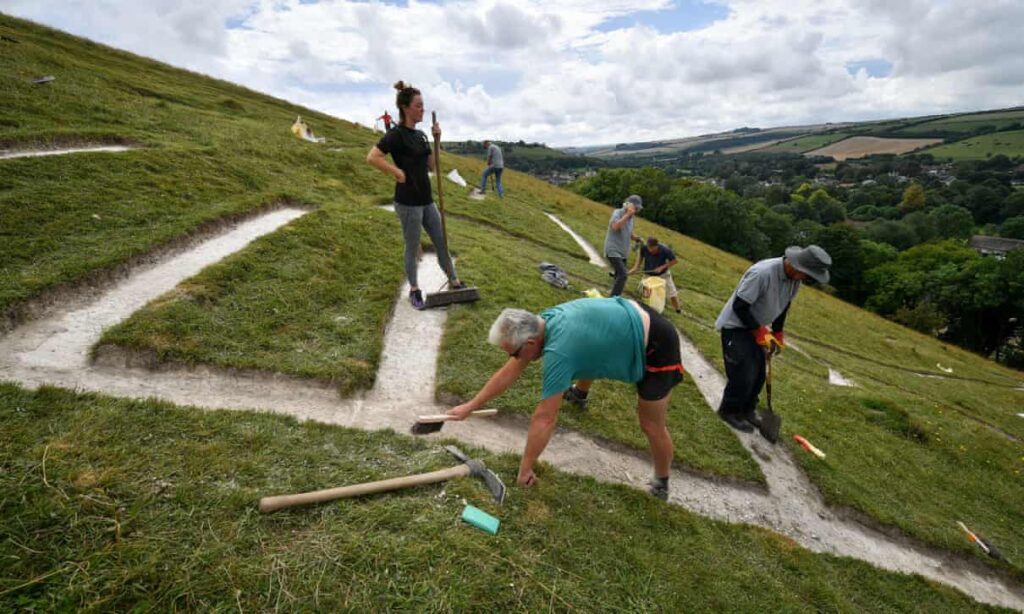Archaeology breakthrough as ‘flabbergasted’ researchers make Cerne Abbas Giant origin find
Over the centuries the huge, naked, club-wielding giant carved into a steep hillside in Dorset has been thought prehistoric, Celtic, Roman or even a 17th-century lampoon of Oliver Cromwell.

After 12 months of new, hi-tech sediment analysis, the National Trust has now revealed the probable truth and experts admit they are taken aback. The bizarre, enigmatic Cerne Giant is none of the above, but late Saxon, possibly 10th century.
Martin Papworth, a senior archaeologist at the trust, said he was somewhat “flabbergasted … He’s not prehistoric, he’s not Roman, he’s sort of Saxon, into the medieval period. I was expecting the 17th century.”
The geoarchaeologist Mike Allen, who has been researching microscopic snails in the sediment, agreed. “This is not what was expected,” he said. “Many archaeologists and historians thought he was prehistoric or post-medieval, but not medieval. Everyone was wrong, and that makes these results even more exciting.”
The research has involved studying samples, which show when individual grains of sand in the sediment were last exposed to sunlight. Material from the deepest layer suggests a date range of 700-AD1100.
It was in the middle of that date range, AD978, that Cerne Abbey was founded nearby. Stories talk about the abbey being set up to convert locals away from worshipping an early Anglo-Saxon god called Heil or Heilith, all of which invites the question, is the giant Heilith?
For various reasons, Papworth said that theory did not ring true. The whole story of the giant is made more confusing by there is no mention of the giant in surviving abbey documents. “Why would a rich and famous abbey – just a few yards away – commission, or sanction, a naked man carved in chalk on the hillside?”
Documents from the 16th and 17th centuries also make no reference to the giant, which suggests to Papworth that it was created and then forgotten about, perhaps overgrown with grass until someone noticed the glimmer of an outline.
Gordon Bishop, chair of the Cerne Historical Society, said the conclusions were as intriguing as they were surprising. “What I am personally pleased about is that the results appear to have put an end to the theory that he was created in the 17th century as an insult to Oliver Cromwell. I thought that rather demeaned the giant.”
Bishop said it seemed to him likely the giant had a religious, albeit pagan, significance. “There’s obviously a lot of research for us to do over the next few years.”
More broadly the analysis results shed important light on the phenomenon of chalk hill figures in Britain, said Allen. “Archaeologists have wanted to pigeonhole chalk hill figures into the same period. But carving these figures was not a particular phase – they’re all individual figures, with local significance, each telling us something about that place and time.”

At 180ft (55 metres) the Cerne Giant is Britain’s largest, rudest and as a result best-known chalk hill figure. He is also the most mysterious.
Some have said he is Hercules. The more fanciful suggest he was an actual giant slain by villagers as he slept on the hill after a busy day eating their livestock.
Many people doubt that the phallus is original. “If he does date to the time of the abbey then he is more acceptable with trousers on than without,” said Papworth.
Asked for his most likely theory on its origins he admitted he was stumped. “I don’t know. I don’t have one. I can’t get my head around it … you can make up all sorts of stories. I don’t know why he is on the hill, I’ve no idea. I can’t work it out. I never would have guessed he would be the 10th century.”





